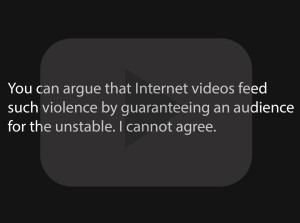The recent tragedy at WDBJ in Roanoke, VA has prompted the usual journalistic introspection about violent imagery. Our industry has shown once again that we are a wild bunch, with no unified standards. Some outlets covering the shooting of Alison Parker and Adam Ward chose to show isolated snippets from the station’s own video of the shooting, which transpired live on air. Some held back. Others went so far as to show bits of the video recorded by the alleged shooter, Vester Flanagan. But some stayed away from those particular images. Decisions were all over the map.

There was a time when these judgments would have felt very weighty, but that time has passed. Personally, I think that is for the best. I chose to view all the videos and can say they were truly horrifying. That was my choice, and I am sure many people will choose differently. On this topic, the Internet truly is a democratic medium. I do not view those beheading videos—again, my choice, and I do not judge those who do look.
TV and newspapers no longer get to decide whether the public should be protected from grisly pictures. We can always go elsewhere. The debates in newsrooms about what to show seem quaint, almost dated. It’s true that TV viewers are in a unique position, because they might be surprised by a sudden gory video. That is why TV long faced tougher scrutiny from regulators.
You can argue that Internet videos feed such violence by guaranteeing an audience for the unstable. I cannot agree. Along with relics like the Fairness Doctrine, our editorial nanny state is being whittled away by YouTube and Twitter. You can avert your eyes, but you cannot stop the change. Journalists can now move on to the more serious business of covering violence and its causes, and stop focusing on ethics questions from a bygone era.
Larry Abramson

I think journalism devolved with the loss of the fairness doctrine. Other than that I agree.
LikeLike